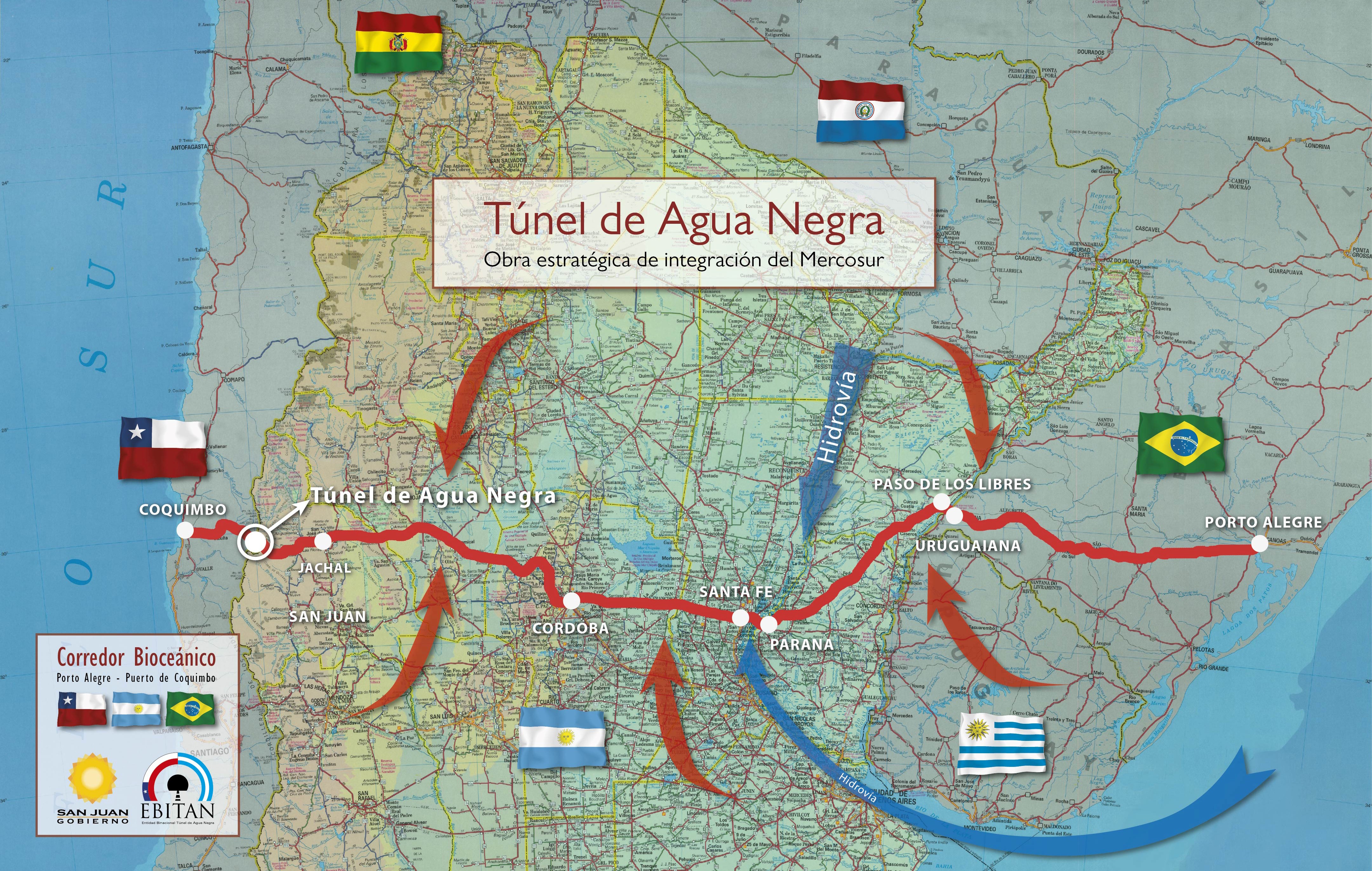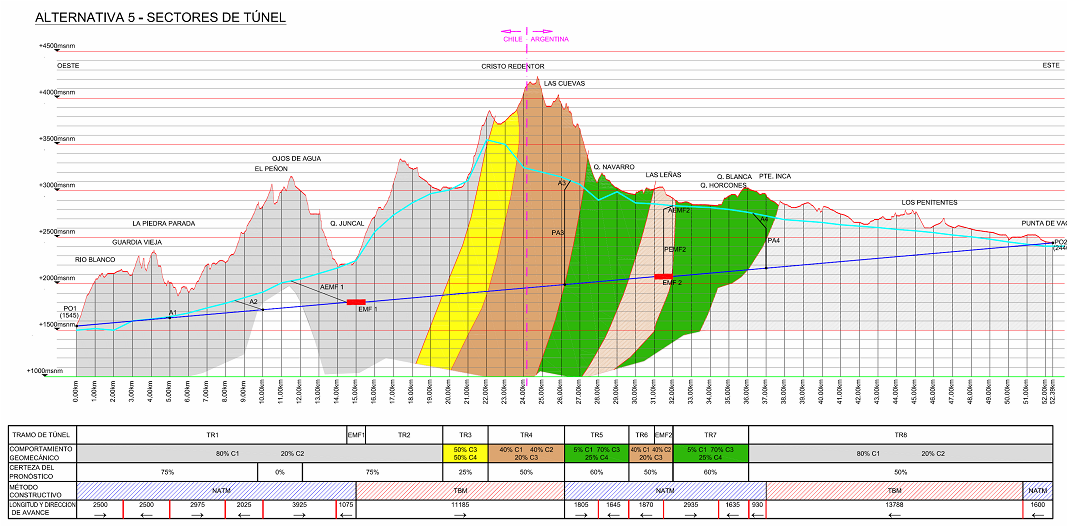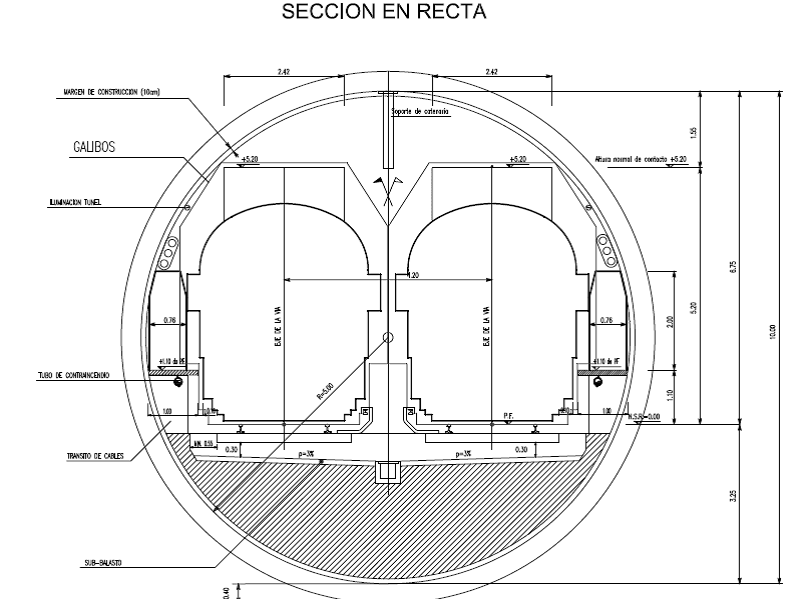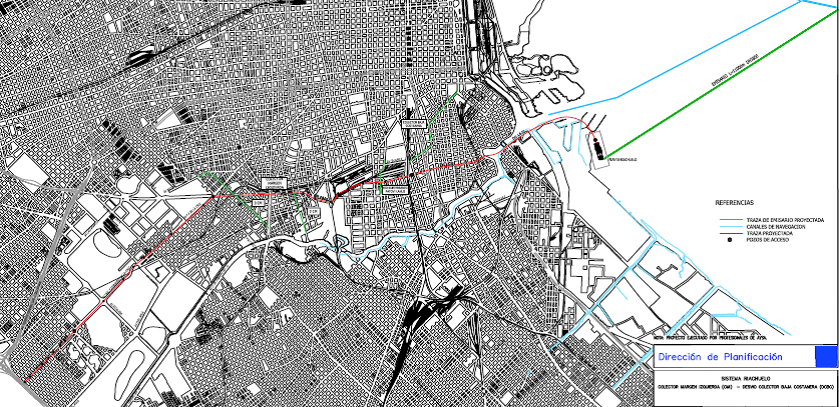
Argentina Activity Report PDF
The significant underground projects which are under construction or in study in Argentina are the following.
Under Construction and recently completed
Extensions of the Buenos Aires Metro Lines, (see Figures below):

Network of the Buenos Aires Metro

Last set of stations inaugurated (yellow); Extensions constructed and ready to be opened in 2013, once the rolling stock does arrive (red) and Extensions still under construction (gray)
Extension of Metro Line A, comprising 2 additional stations and a tail tunnel (cavern) for the parking and maintenance of trains. Stations were executed in cut & cover construction, whereas the 2 track running tunnels and parking cavern were executed with the NATM method. This extension entered in operation in the second semester of 2013.
Extension of Metro Line B, comprising 2 additional stations and a tail tunnel (cavern) for the parking and maintenance of trains. Both stations, the 2 track running tunnels and the parking cavern were executed with the NATM method. This extension entered in operation mid of 2013.
Extension of the Metro Line E, comprising 3 new stations, all of them being under construction with the cut & cover method, and one track twin running tunnels, constructed with the NATM method. This extension is still under construction and should be inaugurated within the present year 2014.
1st Extension of the Metro Line H, comprising 2 new stations (Parque Patricios and Hospitales) and 2 track running tunnels, with both stations in c&c construction and the running tunnels in conventional construction, opened to operation in May 2013.
2nd Extension of the Metro Line H, subdivided into 2 sections:
North section, comprising 4 new stations currently under construction with the NATM method and featuring a single large cavern of approximately 18 m width (Córdoba, Santa Fe, Las Heras, Plaza Francia) and the associated 2 track single tube running tunnels. This section is scheduled to be opened to operation in the second semester of 2015.
South Section, comprising 2 new stations in c&c construction, with the use of diaphragm walls, (Sáenz and Pompeya), and the associated sections of running tunnels, featuring 2 single track EPB tunnels, which construction will be initiated in 2014. There is still no date of inauguration of this section of the line.
Extension of the Metro Line D with a Parking and Workshop tunnel, to be constructed in C&C construction and construction works initiated early 2014.
Purification Plant “Juan Manuel de Rosas” in the northern district of the Metropolitan area of the City of Buenos Aires; Owner is the public water company of Buenos Aires, AYSA: Comprises the construction of a purification plant on a 16 ha site, with a maximum capacity of 975 m3/day, 2 intake tunnels coming from the Lujan river and the Paraná de las Palmas River, the first with an inner diameter of 0,9 m and a length of 5,1 km and the second with a inner diameter of 3,6 m and a length of 15 km, and finally, with 2 outlet tunnels, each one of 1,2 m inner diameter. The 15 km intake tunnel will be constructed by 2 EPB machines, menwhile the other 3 tunnels are planned to be constructed with smaller pipe jacking machines. Currently, the work is under progress and the excavation of the 15 km long intake tunnel with an EPB machine is completed, remaining some repair works to be done at the precast lining.
Sewage Treatment Plant “Planta del Bicentenario” in the southern district of the Metropolitan area of the City of Buenos Aires; Owner is the public water company of Buenos Aires, AYSA: Comprises the construction of a sewage treatment and an emissary tunnel into the La Plata River of 7 km length and 4 m inner diameter, to be constructed with a EPB machine. The treatment plant is terminated, but the construction of the emissary was postponed for a future stage.
Sewer tunnels contracted by the public water company of Buenos Aires, AYSA: considering the so called “West Sewer of Tigre”, Sections 1A, 1B and 1C, to be built by the pipe jacking method, with an inner diameter of 1400 mm and a total length of 4.287 m, and the associated pumping station. Section I and II currently are under construction.
2 Single Road Tunnels for bi-directional traffic on the National Road No. 75, in the Province of La Rioja, with approximate lengths 600 and 900 m, as a part of the construction of a by-pass of the section La Rioja – Dique Los Sauces; Owner: Highway Directorate of the Province of La Rioja.
2 Single Road Tunnels for one way Bus traffic in the city of Buenos Aires, approx. lengths 250 m each, as a part of the Metro-Bus System of this city, which has been initiated in 2013 and presently is being expanded; Owner: Municipality of the City of Buenos Aires.
Projects in Study
Corredor Bioceánico – Túnel de Agua Negra, Argentina / Chile: As a part of this international road connection between Brazil – Argentina – Chile, the design of the Agua Negra Tunnel is in development during the last 5 years, financed by the Govern-ment of the Province of San Juan with the support of the National Government of Argen-tina. It considers an approximately 14 km long twin tube road tunnel operated in one way traffic mode, provided with a ventilation system designed to work in longitudinal mode for normal traffic conditions and in transverse mode for the case of occurrence of fires. This ventilation system is suited by 2 large ventilation caverns, with one of them connected to the outside by a vertical shaft of approximately 550 m depth and the other with a ventilation tunnel of 4, 5 km length. The Basic Design developed for tender purpose in the year 2012 was further revised and adjusted during the year 2013, to be ready for the initiation of the tender process in the year 2014. Meanwhile, mid of 2013 the the bi-national entity EBITAN launched a prequalification process for the construction of the tunnel, which according to the high number of participating groups (22), submitting their documents on November 2013, can be considered as very successful.

Bi-National Corridor associated to the Agua Negra Tunnel and its influence in the Region

Agua Negra Tunnel – Typical Cross Section
Corredor Bioceánico Del Aconcagua – Argentina / Chile:
Corredor Biocáanico Aconcagua (CBA) is a private initiative whose goal is the construction of a state of the art and high load capacity railway network that will establish a new level of physical and commercial integration between the Pacific Ocean and the Atlantic Ocean.
The Cristo Redentor Pass concentrates 70% of land freight that crosses the Andes between Chile and Argentina. Still, today is not a reliable alternative due to high mountain climate causes closures in the pass between 45 and 60 days per year during the period running from May to October, and is near to its capacity saturation with no possibility of achieving gradual expansion. The result of these is that 80% of the cargo flowing between the two bands of the Southern Cone travels by sea, even though these routes are longer and more expensive.
On this basis, the project presented by Corporacion America solves the Mercosur - Chile Axis' bottleneck with the construction of a 205km rail corridor that includes a 52Km base tunnel, which not only would be operational all year round, but also leads to highly significant savings in terms of costs and transit time. Such a system would operate with trains driven by electricity (generated by a hydroelectric dam established in the same area) which would allow the final phase of the project carry up 77 Million tons per year of all types of cargo in different combinations, even trucks with their drivers. This not only improves the crossing itself, but empowers the vast network of roads, rails and ports on both sides of the Andes.

CBA alignment
Optimum Solution = Multimodal Rail System
· Private initiative. Seven years of study / work (since June 2007)
· Electric Railway from Los Andes (Chile) to Lujan de Cuyo (Argentina) - 205 Km
· 52 kilometers base tunnel
· Operating 365 days a year. Avoid high mountains (climate and steep slopes).
· High load capacity (24 million tons / year 1st stage - 77 million tons / year total)
· Today more than 80% of the cargo between both sides of the southern cone travels by sea, given the low efficiency of terrestrial links
Keystones of the project:
· 100% Reliable in logistics: operational crossing 365 days a year
· Long term design: scalable three-stage project, following the demand.
· More efficient logistics: open system with unified gauge (1.676 m), creates a railway link between the Atlantic Ocean and the Pacific Ocean.
· Increased economic efficiency: smaller gradients, which means less time (savings starting at 70% and increasing) and lower energy consumption.
· Increased efficiency and regional competitiveness.

Long cross section of the proposed Base Tunel, showing both multifunctional emergency stations
The mentioned base tunnel is designed as a twin single track tunnel system, including among other features 2 multifunctional stations designed to provide rescue possibilities for the passengers in the case of an emergency within the tunnel. According to the Preliminary Design so far developed for the purpose of tendering this project, this railway corridor would exhibit a maximum transport capacity of 77 millions of tons per year, once the proposed railway corridor would be fully operable with a continuous double track line and a number of logistic freight distribution centres in both countries. The final decision / approval of the project is expected to be given by the present government of the President Bachelet, allowing the Binantional Entity the start of the tender process.
Sarmiento Railway Tunnel in the city of Buenos Aires:
This project consists of the replacement of the present Railway Line “Sarmiento”, running from the Western Head Station of the city of Buenos Aires until the end station of the metropolitan area, located at a distance of approximately 32 km, by a completely new underground construction, which is based on a double track 12 m inner diameter tunnel, to be excavated with a EPB shield machine. This project, which is financed by the national government, was awarded to joint venture of contactors coming from Italy, Brazil, Spain and Argentina, which presently is developing the detail design of the whole project and preparing the start of the first phase of 3 construction phases. The mentioned 1st phase involves 16, 67 km of line, with 12,2 km to be constructed in mined construction, and 8 underground stations, most of them to be constructed with the c&c method. In the year 2012 the construction works did start, basically in terms of preparation of all necessary works for the launching of the excavation of the EPB machine, which was purchased from the manufacturer Herrenknecht. Since this machine is not a new one, it was refurbished by the own manufacturer at the construction site. However, before the tunnel excavation could start, a negotiation period between the Owner and the Contractor JV was initiated, in order to re-evaluate the financing source and conditions for the construction. The result of this process was the restructuration of the construction JV and a change in the financing source, which now will be the National Development Bank of Brazil, BNDES. Presently, even without re-start of the construction activities, the construction JV is further developing the detail design of the project.


View of the Herrenknecht cutter head of an used shield machine, which presently is being refurbished by the Contractor, and of the typical tunnel profile
Sustainable Development Plan of the Matanza – Riachuelo Basin, city of Buenos Aires, including the sewer “Colector Margen Izquierda, Desvío Colector Baja Costanera y Obras Complemen-tarias”, a Treatment Plant and an emissary “Emisario Planta Riachuelo”:
This project comprises the construction of one main sewer, which will be located parallel to the Riachuelo River, on its left margin, in order to collect basically the sewage water coming from the industrial plants located alongside of this river. This sewer will have a length of approx. 10 km and an inner diameter of 2, 9 m, to be built with a pipe jacking system and a EPB machine. Additionally, a second sewer is considered, coming from the West, which will have an inner diameter of 4, 5 m, a length of 5, 4 km, to be built with an EPB machine. Finally, the emissary is designed to be approximately 10, 5 km long, having an inner diameter of 4, 1 m and to be built with an EPB machine. The tender process for construction and site inspection of 3 contracts (emissary, treatment plant and sewer) is finished and the construction JV’s and Site Inspection contracts awarded. The construction should start approximately mid of 2014.

Plan view of Riachuelo River, the proposed sewer tunnels (red and green) and the emissary (also green)
Túnel Las Leñas, Province of Mendoza (Argentina) and IVth Region (Chile):
15 years after the development of a feasibility study and preliminary design of the so called “Las Leñas Road Tunnel”, crossing the Andes Range with a length of 13 km at the South of the Mendoza Province, in Argentina, an update of the existing feasibility study has been tendered and awarded in 2013, both in Argentina and Chile, being the services presently in execution until approximately mid of 2014. Both countries decided not to joinly develop the complete project, but subdivide it in two parts, to be independently developed in each country. The scope of the Argentine part of the project encompasses the approximately 74 km long access road until the tunnel portal. Meanwhile, at the Chilean side it includes not only the Western access road to the tunnel, but also the tunnel itself. Both access roads have to be developed on a tender design level, meanwhile for the tunnel only a general conceptual design is requested. Besides, also a detailed geological – hydrogeological mapping along the tunnel corridor is included as a part of the Chilean tender.
Relief Tunnels for the existing Medrano and Vega tunnels for rain water collection, located in the city of Buenos Aires, North of the Maldonado Basin:
Comprises the construction of 2 EPB relief tunnels for both existing tunnels, which lengths are of 5,18 and 8,4 km respectively for the Medrano and Vega Basin, with an excavation diameter of 7,8 m. On the following illustration the basins and alignment of all relief tunnels (Maldonado, Medrano & Vega) can be seen. Currently, the tender process for the first of these relief tunnels, the Vega Tunnel, was launched end of 2013, with the expectation of start of construction after mid of 2014. The Prequalification process for the consulting companies applying for the Site Inspection is under progress.
.png)
.png)
Vega & Medrano Basins and proposed Relief Tunnel System

